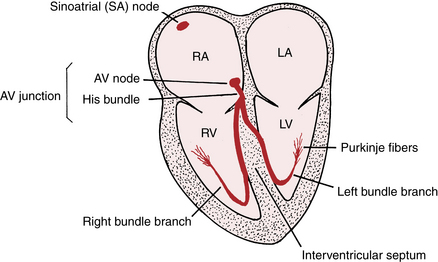Chapter 1 Key Concepts
Please go to expertconsult.com for supplemental chapter material.
The device used to obtain and display the conventional ECG is called the electrocardiograph, or ECG machine. It records cardiac electrical currents (voltages or potentials) by means of conductive electrodes selectively positioned on the surface of the body.∗
Essential Cardiac Electrophysiology
Electrical Activation of the Heart
In simplest terms, therefore, the heart can be thought of as an electrically timed pump. The electrical “wiring” is outlined in Figure 1-1.
The AV junction, which acts as an electrical “relay” connecting the atria and ventricles, is located at the base of the interatrial septum and extends into the interventricular septum (see Fig. 1-1).
Stay updated, free articles. Join our Telegram channel

Full access? Get Clinical Tree



